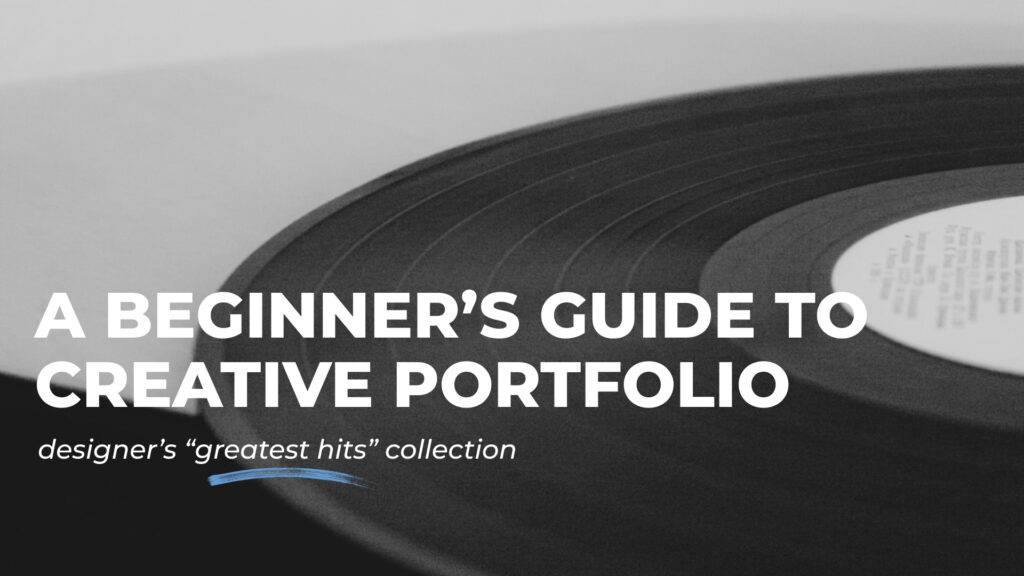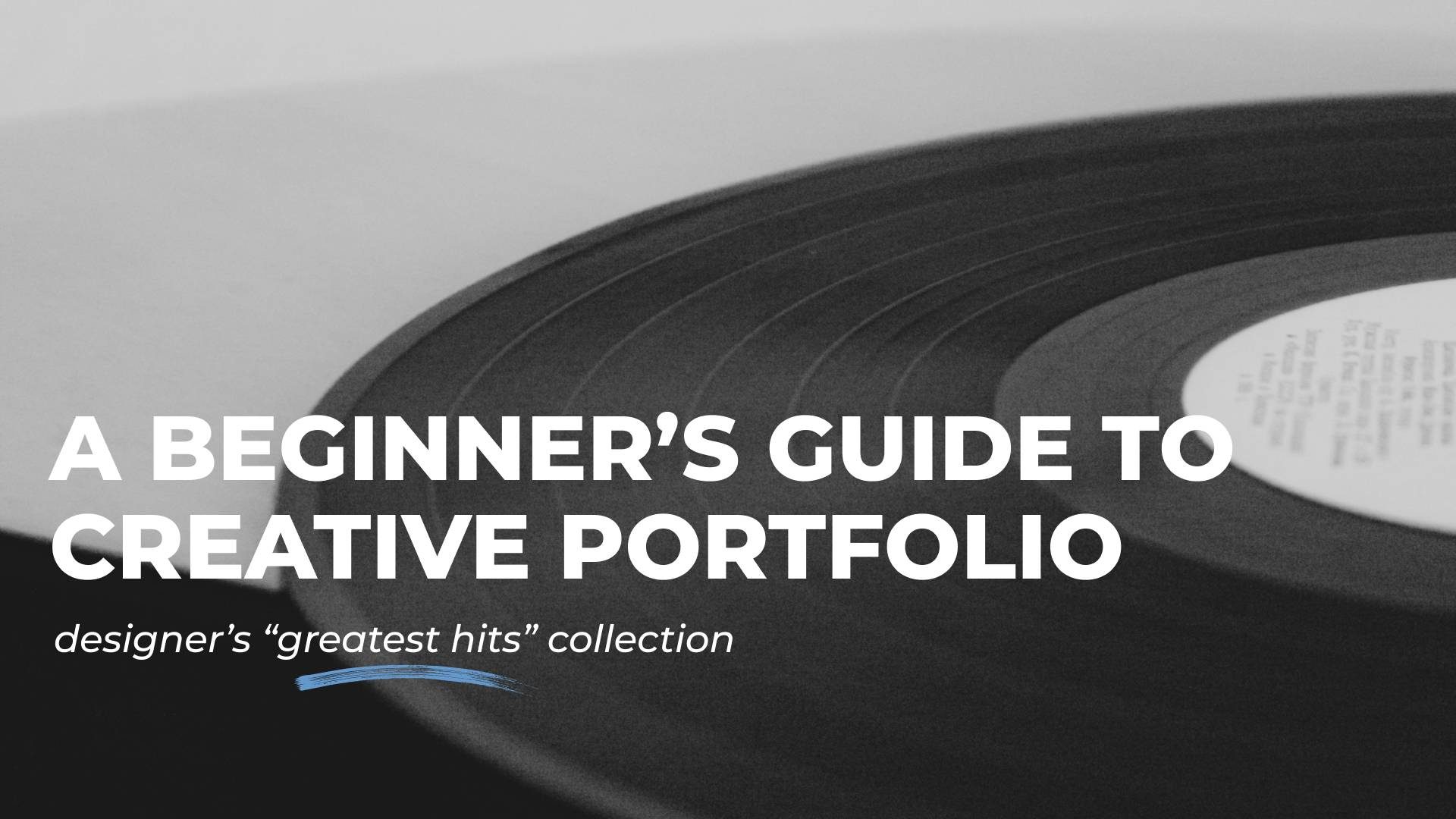So you’ve passed some cool graphic design courses, completed your first commission, and think your creative expertise is now worth wider attention. And here comes the next challenge: How do you actually get people to notice and hire you?
For starters, you can post your resume or scroll through dozens of job offers. Then there’s sending cold emails and networking at events. And sure, all of that helps. However, at some point, everyone’s going to ask the same question: “Can I see your work?”
And that’s, my friend, the moment you introduce your best marketing tool – “Sure! I’ll send you my portfolio.”
Table of contents:
What Is a Design Portfolio?
In simple terms, a graphic design portfolio is a curated collection of your work that shows your skills, style, and the kind of projects you specialize in. Similar to a retail display or a greatest hits album, a design portfolio demonstrates your best work and the services you provide in detail.
For your potential clients or employers, it serves as a visual representation of how you design, solve problems, and create something that looks great and works even better. There, they can get to know you and see whether your experience and skills align with their needs and requirements. A design portfolio is essentially what lets people evaluate your expertise.

How to Make a Graphic Design Portfolio?
What you need to remember is that a portfolio is not just about throwing your projects into a folder and calling it a day. Chaos won’t do you any good. What should be in a graphic design portfolio is a question solved with a strategic approach.
Given that your portfolio can be a make-or-break for the client, creating one might put some pressure on you. To make things easier, I’ll now explain the basics of how to build a graphic design portfolio.
To start with, let’s have a look at the following 5 principles:
Select different project types
It’s crucial to indicate how versatile you are. If the only examples of work you provide are logo designs, people are going to assume that’s all you can do. Even if you are gorgeous at logos, it’s better to show you can handle a creative challenge.
So instead of staying in one strict lane, deliver some range. Alongside logos, present a branding project or a packaging graphics. You don’t have to go on a graphic design rampage – just establish all the skills to the fullest and let in more job opportunities.
Quality over quantity
Our attention span is not getting any better lately, so consider this before adding 50 projects to your portfolio. Instead of cluttering the space with numerous mid projects, select 5-10 pieces you feel really proud of. A design portfolio is not an archive of everything you’ve ever done. It’s a marketing catalogue and there is no place for fillers.
Moreover, a cluttered portfolio makes you look indecisive or desperate at best and unprofessional at worst. It can also dilute your best work. So, when in doubt, leave it out. Better post less, but maintain a slick and competent look.
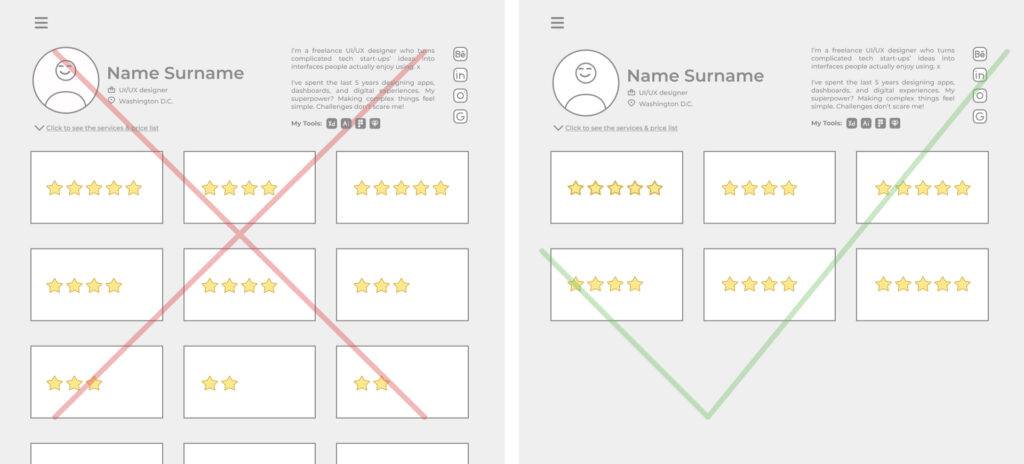
State your expertise
Graphic design has many branches and directions. A UI/UX specialist, a brand identity professional, a packaging design pro… you name it. While being a jack of all trades sounds good in theory, the “I do everything” approach is often seen as “I don’t excel in anything specific.” That’s why your portfolio should have coherence.
There has to be a clear thread running through all your projects, so that people see what you’re all about. The clearer you are about your niche, the easier it is for clients or employers to find you. If someone looks at your portfolio and can’t figure out what you specialize in, that’s a problem.
Need to review your portfolio?

Make sure your portfolio is coherent and has a professional look with Approval Studio!
Start a Free TrialDecide on your target audience
While organizing your creative portfolio, think of who you are trying to attract. Are you aiming for agencies, freelance, or in-house positions? Would you prefer a local business or a remote job? If you have in mind a cutting-edge tech company, your portfolio will look and feel different from the one that lands you a cozy local coffee shop position.
Your self-pitching approach must align with your ideal client’s requirements. Who are they? What are they after? What problems do they need solved? What style appeals to them? The design portfolio should speak directly to whoever you want to hire you.
Regularly update your portfolio
Unfortunately, your portfolio maintenance doesn’t stop once you hit the submit button. One of the most important rules in the creative industry is to stay up-to-date and relevant. Design trends change, your skills improve, and your style evolves, too. Old, outdated work damages your image and takes up space.
To keep your portfolio working for you, set a review schedule about every 3-6 months. Additionally, set up analytics to monitor which projects gain the most appreciation. Based on what resonates best, remove the irrelevant pieces and add new work that represents your current level.
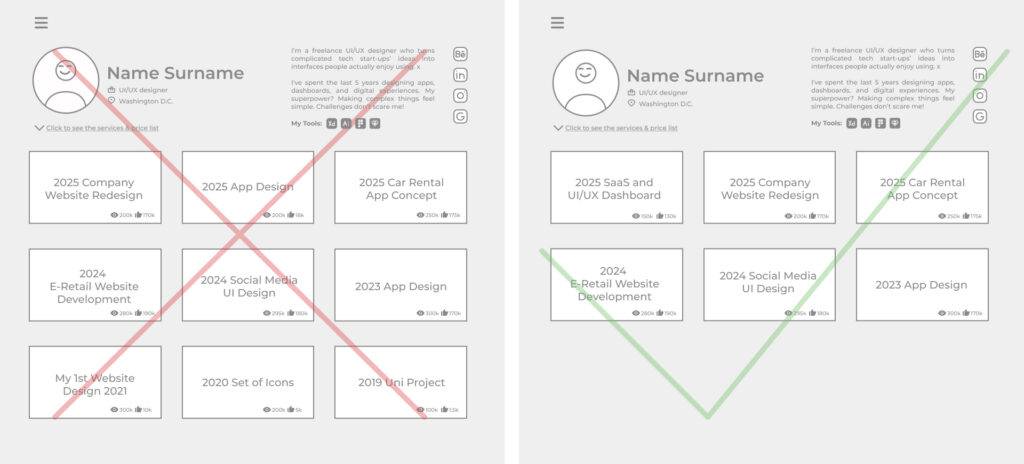
What Makes a Portfolio Stand Out?
Now that you’ve built your creative portfolio, we’ll talk about some adornments and upgrades you can consider to outshine the dozens of others. Because why stop at being average when you can learn to leave an impression?
Compelling case studies
Even the most appealing visuals aren’t always memorable. What adds volume and depth to them is the storytelling. Case studies provide context, letting the audience relate to your experience.
Design that actually works is more than pretty. It’s a complicated process that solves real problems. If you’re looking for clients who care about strategy, give them a peek inside your creative process. Tell the audience what the challenge was, what approach you took, and what your decisions finally resulted in.
Problem-solving approach
Following up on the previous point, don’t be afraid to pull back the curtain. Work process iterations make your portfolio more interesting and prove you didn’t just get lucky with a good design. It strengthens your image with intentionality and thoughtfulness.

Clients and employers love to see how you think when you execute. To show that, include sketches, moodboards, and concept research you did. Explain how you approached the problem and why you chose one option over another. Your journey is as important as the final product.
Personal style flexibility
Previously, I’ve mentioned style as a vital attribute of a graphic designer. Working with a format gives your work personality and makes it recognizable amongst others. However, as with everything, moderation is key, and you don’t want to overdo it.
By that I mean restricting yourself to one mould and producing a type of “same thing, different font” designs. When you establish yourself as a one-trick pony, instead of praising your style, people will start thinking, “Okay, they just do the same thing over again.” So show you can adapt and experiment because there’s a difference between consistency and being a broken record.
Other Small But Important Elements
Now you might think you know exactly what to include in a graphic design portfolio. However, the devil is in the details, and sometimes we forget about the simplest things. Apart from the actual design portfolio, you might miss out on the portfolio design. Say, the “About me” section.
About section
In a few paragraphs, establish your personality and how you want to be perceived. Share your vision, background, and experience shortly for clients to know who they will be dealing with. Give people a sense of who you are without writing an autobiography.
And to strengthen your image, add a profile photo. This small detail makes you feel more real to the clients and therefore builds trust.
Services you provide
Continuing on what builds trust, be transparent about the services you provide and their approximate pricing. Clarity also saves time, yours and the client’s. For instance, those who can’t afford your services won’t bother you, while serious clients often value transparency.
Another important aspect is timelines. Alongside the types of projects you take on, put the approximate amount of time it usually takes you to complete each of them. If you manage expectations upfront, it’ll prevent headaches later.

Navigation and optimization
Given that you create a portfolio as your own website, you must think of the UX part. The easier it is to navigate, the better. Potential clients should be able to find everything important in two clicks. Otherwise, nobody is going to try and decode your complicated site structure.
The same goes for speed. I really doubt you enjoy waiting extra seconds while something is loading or lagging. The truth is, you can have the most exceptional projects out there, but people won’t see them simply because an image is too heavy to load.
Learn some SEO basics
For a creative, SEO is one of those nice-to-have skills. And you don’t have to go deep – just the fundamentals are enough to give your searchability a noticeable boost.
To put it shortly, naming your project “Brand identity for a car rental company” is much better than “Project_5”. Another aspect is descriptive alt texts for the visual part. And a great bonus would be to find a site willing to list you in their designer directories. For example, our Creative Talks issue!
How to Set Up a Graphic Design Portfolio?
With all that said, now comes the time we find a place to host your creative portfolio. The options are multiple, so let’s go and find the one that caters to your specific needs.

Behance/Dribble/Adobe
The usual go-to choice. And there’s no magic trick behind it. These platforms are mostly free, easy to use, and already have an active audience browsing for inspiration or talent.
+ You don’t need technical skills to set it up.
+ Local communities serve as a great source of networking.
– Users’ portfolios look similar due to the limited templates.
– You have no control over the platform (in case they shut down).
Specialized platform
The cooler Behance. With platforms like Format, Cargo, or Squarespace, you can create a customized portfolio. This is the middle ground between the previous and a personal website.
+ Still no need for technical skills.
+ Control over your branding and a custom domain.
– Requires you to pay monthly fees.
– Customizable, but not as much as a personal website.
Personal website
Services provided by WordPress or CMS let you create a highly customizable portfolio from scratch. Here, you’re not restricted to any templates or rules – full control.
+ Go as far with your creative freedom as you can.
+ A great way to show off your web design skills if that’s your thing.
– Requires you to pay hosting fees.
– Needs regular maintenance (or hiring a professional).
Multi-platform approach
The more the merrier. To gain more visibility and engagement, you’ll want to be ubiquitous. Each of the platforms we’ve discussed reaches different audiences, so why miss out on that?
Additionally, social media self-promotion is no joke either. If you’re active on Instagram, Twitter, and LinkedIn, your discoverability levels up. Moreover, posting behind-the-scenes content and sharing your working process helps you bond better with your audience through a personal, relatable experience.
Before You Publish: A 7-Step Checklist
Congratulations! You’ve reached the point when every aspect is decided. Now, let’s talk about how to end a portfolio. Because the super important final step is revision. Don’t let a small mistake ruin your portfolio, and use the following checklist to make sure it’s ready to be posted.
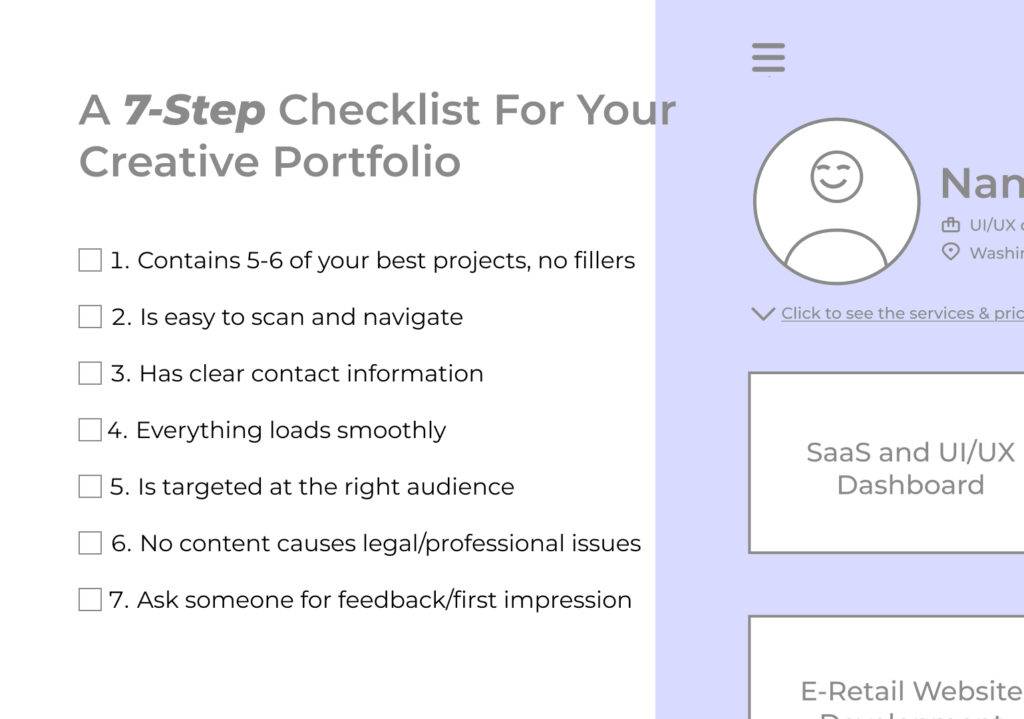
Conclusion
For a designer who wants the world to see their work, it’s important to learn what makes a good graphic design portfolio. And I hope this article has been of great help in your studies.
To sum it up, the crucial element of a successful design portfolio is an understanding that it’s an ongoing project that grows alongside you and your creative career. Don’t be afraid to start, for it doesn’t have to be perfect to launch. Mind the foundation, which is your strongest projects, compelling storytelling, and easy navigation. Then monitor what works and update the portfolio according to your findings.
The key is to get something out there. Now, go and try to apply the things you’ve learned today in practice. Your portfolio isn’t gonna create itself 😉

 TEAM SOLUTIONS
TEAM SOLUTIONS WORKFLOW SOLUTIONS
WORKFLOW SOLUTIONS



 REVIEW TOOL
REVIEW TOOL PROJECT MANAGEMENT
PROJECT MANAGEMENT TOOLS & INTEGRATIONS
TOOLS & INTEGRATIONS
 CLIENT INTERVIEWS
CLIENT INTERVIEWS








